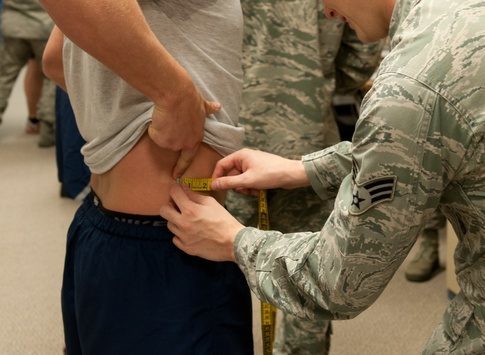For the first time in years, the Pentagon has updated its Physical Fitness/Body Composition program, granting the services wider latitude to devise their own systems and tests.
DOD Instruction 1308.03, issued March 10, allows the respective services to measure body composition using “[body fat] calculations, waist-to-height ratio, abdominal circumference, height-weight screening, or any combination thereof.” The Defense Department previously mandated that all services use “circumference-based methods”—commonly referred to as the tape test.
There are still standards that have to be met, though. If services continue to use body fat calculations, they must set standards no higher than 26 percent and no lower than 18 percent for men, and no higher than 36 percent and no lower than 26 percent for women.
If the services choose to use height-weight screening, sometimes called body mass index, the upper standard has to be between 27.5 and 25, and the lower standard has to be at least 19.
If the services use circumference tests, they’ll have to “use evidence-based reference indexes corrected for height that are not biased against short or tall service members,” the instruction continues, recommending that any circumference test also incorporates height.
For years now, service members have complained that circumference tests don’t always accurately measure body fat. In some cases, service members say they have excelled during PT tests, only to fail the body measurement.
The new DOD instruction includes a clause seemingly addressing that issue as well, allowing the services to “implement policies that exempt personnel from negative consequences of exceeding body fat standards if high scores on physical fitness tests are attained.”
The Air Force made waves recently when images leaked on social media purported to show the service’s new scoring chart for waist-to-height ratio—any ratio between 0.40 to 0.49 would be deemed low risk; a number between 0.50 and 0.54 would be deemed a moderate risk while still meeting Air Force standards; and any number at 0.55 or above would be deemed high risk.
The Air Force surgeon general’s office stated at the time that any images released were “pre-decisional and subject to change.” The office has said it has settled on waist-to-height ratio as “the best available method for assessing body composition.”
The changes to the DOD instruction regarding physical fitness programs are less dramatic, but still telling. Whereas previous versions of the instruction included specific examples of exercises to measure aerobic capacity, muscular strength, and muscular endurance such as running, sit-ups, and pull-ups, the new instruction does not include any examples.
This shift comes after the Air Force introduced new alternate exercises into its PT test, as the Army presses forward with its new-look fitness test, and AS the Space Force looks to move away from the once-a-year test entirely, instead relying on wearable fitness trackers and software solutions to continuously monitor Guardians’ health.
The new instruction still calls for the services to test for cardiorespiratory endurance, muscular strength, and muscular endurance.

